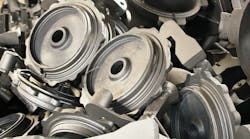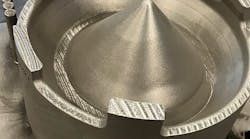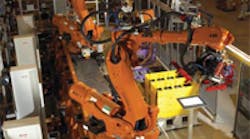Whenever a new metalcasting operation is built, the focus for the design centers on the production process: how the metal is melted, poured, molded, and how the castings are machined and/or finished. Comparatively little attention is given to how all those things happen — how does the production process move from one stage to the next?
Metalcasters, and other manufacturers, would rather avoid deeper explorations of their robotic systems, and many of them have adopted the more benign term “automation” to explain the labor savings they achieve. But, there are other more pertinent benefits to robotic systems, such as time savings, quality improvements, and reliability advantages.
According to Ralph Perkul of Foundry Solutions & Design (www.foundrysd.com), North American metalcasters are adopting robotic automation in a more piecemeal fashion. FS&D engineers robotic systems for new operations as well as plants that are remodeling or retooling. They do not develop robotic equipment: they integrate the optimal machinery to the plans for new operations.
“The usual application is in casting handling,” Perkul opines. He lists machine tending for core machines and diecasting machines among the more common installations. Other robotic systems FS&D has installed in North America perform metal removal (grinding and finishing castings) and core assembly; in aluminum foundries, automated pouring is common. “As usual, it’s starting with the large foundries, but is now finding application in smaller shops,” Perkul points out. FS&D’s most notable robotics projects confirm this view: it automated the finishing operations for GM Powertrain at Defiance, OH, and Castech in Saltillo, Mexico.
The point of view is only slightly different from a designer of a robotic equipment. ABB Robotics is one of the foremost developers of automation systems, and metalcasting systems are one of the industries where ABB maintains a focused design approach. Doug Niebruegge, the foundry and plastics segment manager for ABB Robotics Inc. (www.abb.com), notes that the common applications are material handling, molding and casting machine tending, die spraying, core assembly, and material removal (grinding, deflashing, deburring, and polishing.) “Pouring is done, but it’s not common in North America,” Niebruegge offers.
So, between the machine designers and the system integrators, are there ways to identify likely new clients in North America? “The largest casters by tonnage are most likely to invest in automation,” Niebruegge reveals, “but that is not the whole story. ‘Aluminum’ is a growth area, with new capacity being added, which is a good indicator. Ergonomic and bad working conditions are motivators, so materialremoval applications are good targets,” he details. But, overall, he claims that a company’s management philosophy is the most likely indicator of a willingness to adopt robotic systems, for whatever process goals they set.
According to Perkul, the decreasing cost of robots, and metalcasters’ desire to stay competitive, means that even small shops are adapting robots especially for applications involving repetitive processes. “Normally, aluminum diecasters who are in high production are the most advanced in this area,” he believes.
Both experts agree that labor- cost reductions and product quality and consistency are among the leading reasons for metalcasters to adopt robotic systems. The ergonomic advantages that robots allow are a more specific comment on the possibilities of automation, and the difficulties of metalcasting operations.
So, in a market with so many different production needs, and so many varying operational goals, are there difficulties in introducing new technologies. Niebruegge says not really, that new robots are less of a concern than new technological capabilities in vision and force control. “This industry wants to see successful installations of an application or part that is similar to the prospective customer. New technology needs to be demonstrated that it works as advertised, which requires investment, and slows the process until an installed base is established and documented.”
In that light, ABB earlier this year introduced its Vision Guided Robotics line with TrueView capability, which allows robots to “see” and “comprehend” information about their environment, such as variations in part position, type, style and quality, in real-time, so metalcasters can achieve new standards of manufacturing efficiency and profitability.
In North America, new capabilities also create retrofitting opportunities for existing robotics systems. “Retrofitting can be as successful as a new, clean-sheet design,” according to Niebruegge, “as long as no compromises are made to keep equipment or floor plans that do not lend themselves to good automation.










